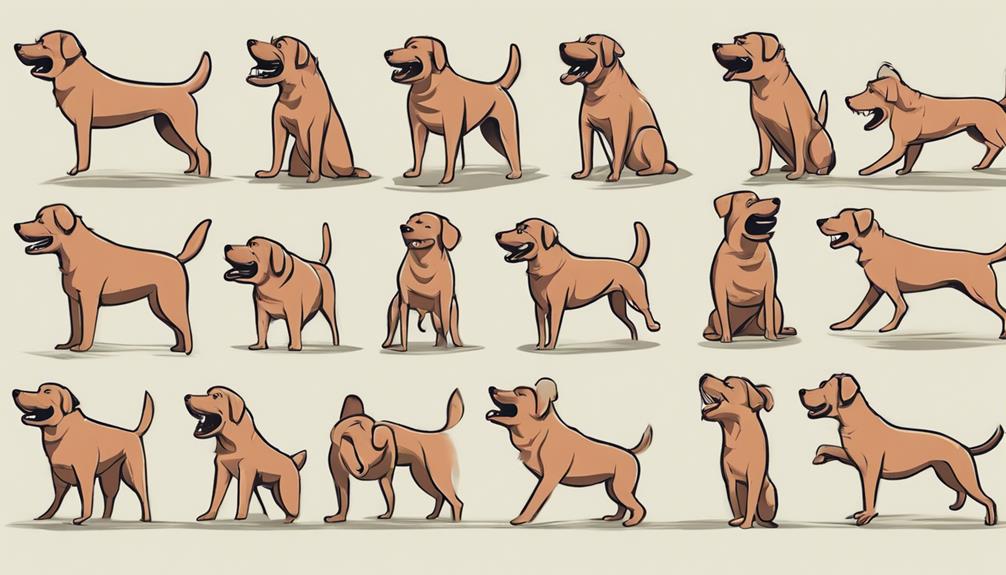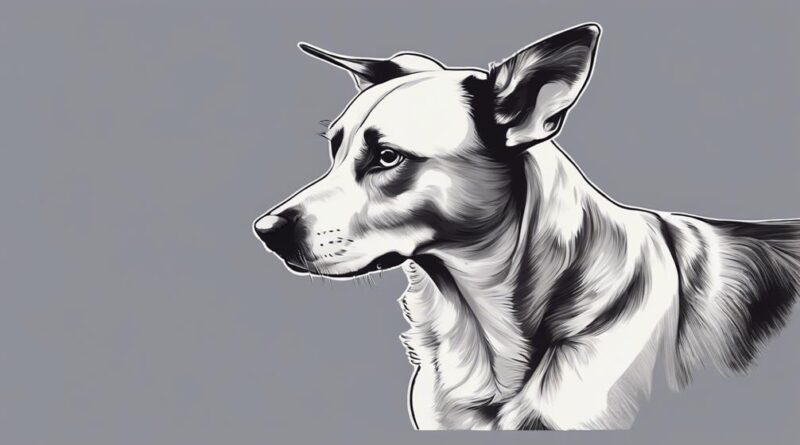Unraveling the Scientific Secrets of Canine Communication
Ever wondered what your furry friend is really trying to tell you?
Canine communication is a fascinating subject that goes beyond just barks and tail wags.
By unraveling the scientific secrets behind how dogs interact with each other and with humans, you'll gain a whole new perspective on your four-legged companion.
From subtle body language cues to complex vocalizations, understanding the intricacies of dog communication can deepen your bond and improve your relationship.
Stay tuned to uncover the hidden language of man's best friend.
Canine Body Language Signals
Understanding your dog's body language can provide valuable insights into their feelings and intentions. Facial expressions play a crucial role in deciphering what your furry friend is trying to communicate. A relaxed face with soft eyes and a slightly open mouth usually indicates a content and happy dog. On the other hand, a tense face with narrowed eyes and lips pulled back may signal fear or aggression. Observing your dog's facial expressions in different situations can help you better understand their emotional state.
Ear positions are another important aspect of canine body language. Dogs have a wide range of ear positions that convey various messages. Ears held high and slightly forward typically indicate alertness or curiosity. Conversely, ears flattened against the head may suggest fear or submission. By paying attention to your dog's ear movements, you can gather valuable information about how they're feeling in a particular moment.
Next, let's delve into vocalizations and their meanings to further enhance your understanding of your canine companion's communication cues.
Vocalizations and Their Meanings
Dogs communicate through a variety of vocalizations that convey different meanings and emotions. They use pitch variations and frequency patterns to express themselves, providing valuable insights into their state of mind and intentions. Understanding these vocal cues can deepen your bond with your furry companion and enhance your ability to respond appropriately to their needs.
- Pitch Variations: Pay attention to changes in your dog's vocal pitch, as high-pitched sounds often indicate excitement or distress, while lower tones may suggest calmness or warning signals.
- Emotional Cues: Dogs use different vocalizations to convey emotions such as happiness, fear, or frustration, enabling you to gauge their emotional state and respond accordingly.
- Frequency Patterns: The frequency at which your dog vocalizes can offer insights into their social interactions, such as seeking attention, expressing discomfort, or signaling playfulness.
- Social Interactions: Vocalizations play a crucial role in canine social dynamics, helping dogs establish hierarchies, communicate boundaries, and strengthen bonds within their pack.
Olfactory Communication in Dogs
Pay attention to the scents your canine companion leaves behind, as these olfactory signals play a significant role in their communication with others. Dogs engage in scent marking as a way to communicate their presence, territory, and social status to other animals. This behavior involves depositing small amounts of urine or feces in strategic locations. Through scent marking, dogs can convey information about their identity, reproductive status, and even emotional state.
Pheromone communication is another crucial aspect of olfactory communication in dogs. Pheromones are chemical signals that can elicit specific responses in other members of the same species. Dogs release pheromones through various glands located on their bodies, such as the anal glands and paw pads. These pheromones can help dogs communicate information about fear, stress, or contentment to other dogs in their environment. Understanding the role of scent marking and pheromone communication can provide valuable insights into the intricate ways in which dogs interact and communicate with one another.
Understanding Tail Wagging
When observing your canine companion's tail wagging, take note of the speed and direction as these movements convey important information about their current emotional state and intentions. Tail wagging dynamics and behavioral cues play a crucial role in understanding what your dog is trying to communicate.
Here are four key points to help you decode your furry friend's tail language:
- Speed Matters: A fast wag usually indicates excitement or agitation, while a slow wag might signal insecurity or hesitation.
- Direction Is Key: Pay attention to which side your dog's tail is wagging towards. Wagging to the right often signifies positive feelings, whereas left-side wagging can indicate negative emotions.
- Whole Body Wag: A wag that involves the entire body suggests extreme happiness or a friendly greeting.
- Stiff Wagging: If the tail appears stiff while wagging, it could be a sign of alertness or even aggression.
Understanding these nuances in your dog's tail wagging can help you better comprehend the emotions conveyed and the communication signals they're sending your way.
Eye Contact and Its Significance
As you observe your furry companion, take note of the significance of eye contact in deciphering their emotions and intentions. Dogs use eye contact as a powerful form of communication, conveying a range of feelings through their gaze behavior. When your dog looks into your eyes, they aren't only seeking information but also establishing a connection with you.
Research has shown that dogs can engage in emotion recognition by looking at human facial expressions, mirroring our feelings. This mutual gaze enhances bonding cues between you and your canine friend, strengthening the emotional bond you share.
Facial expressions play a crucial role in this interaction, as dogs can pick up on subtle changes in your face to interpret your mood. Likewise, when you meet their gaze, they can understand your emotions through your facial expressions. By paying attention to your dog's eye contact and responding in kind, you can foster a deeper understanding and connection, enriching your relationship with your loyal companion.
Postures and Gestures Decoded
Deciphering your dog's postures and gestures provides valuable insights into their feelings and intentions. Observing how your furry friend moves and positions themselves can reveal a wealth of information about their current state of mind. Here are some key points to keep in mind:
- Playful antics: When your dog is feeling playful, you may notice them bowing down with their front legs stretched out and their hindquarters in the air. This posture signals an invitation to engage in fun and games.
- Submissive signals: Dogs may exhibit submissive behaviors by lowering their bodies, tucking their tails, and averting their gaze. These gestures indicate a desire to avoid conflict and show deference to others.
- Pay attention to your dog's overall body language, including the position of their ears, tail, and the tension in their muscles. These subtle cues can provide clues about how your dog is feeling in a given situation.
- Remember that each dog is unique, so it's essential to familiarize yourself with your pet's individual postures and gestures to better understand their communication style.
The Role of Barking

To further understand your dog's communication cues, let's explore the significance of their barking behavior. Barking behavior serves as one of the key canine vocalizations and communication patterns. Dogs bark for various reasons, each carrying distinct behavioral cues. Paying attention to these cues can help you decipher what your furry friend might be trying to convey.
Understanding your dog's barking behavior can provide insights into their emotional state and intentions. For example, a sharp, repetitive bark may signal alertness or warning, while a lower-pitched, prolonged bark could indicate loneliness or a desire for attention. By recognizing these behavioral cues in their barks, you can respond appropriately to meet your dog's needs and strengthen your bond.
Moreover, the frequency, pitch, and intensity of barking can also reveal valuable information about your dog's environment and interactions with other animals or humans. By being attentive to these nuances in their barking behavior, you can better navigate communication with your canine companion.
Interpreting Social Behavior
Exploring your dog's social behavior reveals valuable insights into their interactions with other canines and humans. Understanding their play behavior analysis can provide clues about how they communicate and establish relationships within their social groups. Observing dominance hierarchy dynamics among dogs can shed light on their leadership roles and preferred social structures. Pack dynamics play a crucial role in shaping your dog's behavior and can influence how they interact with both familiar and unfamiliar individuals. By recognizing the significance of social interactions in your dog's life, you can develop a deeper bond with them and create a more enriching environment for their social development.
- Analyzing play behavior: Delve into the intricate world of canine play to uncover the nuances of their communication skills.
- Exploring dominance hierarchy: Understand the importance of hierarchies in shaping your dog's behavior and relationships.
- Observing pack dynamics: Witness firsthand how pack dynamics influence your dog's social behavior and interactions.
- Recognizing social interactions: Appreciate the role of social interactions in your dog's life and how they shape their overall well-being.
Frequently Asked Questions
Can Dogs Understand Human Body Language Signals as Well?
Yes, dogs can understand human body language signals as well. They interpret your gestures, facial expressions, and posture to gauge your mood and intentions.
In addition to vocal cues, dogs rely heavily on human interaction to understand your emotions. By observing your body language, they can pick up on subtle cues that can help them interpret your feelings and respond accordingly.
This ability strengthens the bond between you and your furry friend.
How Do Dogs Use Their Sense of Smell to Communicate With Each Other?
Dogs use their sense of smell to communicate with each other by scent marking to establish dominance. Through chemical signals, they convey information about their identity, social status, and health. This form of communication helps dogs establish and maintain their social hierarchy within a pack.
What Does It Mean When a Dog's Tail Is Wagging in a Circular Motion?
When a dog's tail is wagging in a circular motion, it usually means they're feeling happy or excited. This tail behavior is a clear indication of positive canine emotions.
Circular wagging is linked to dog psychology, showing that your furry friend is in a good mood. It's their way of communicating their joy and affection towards you or something they find enjoyable.
How Can Eye Contact Affect a Dog's Behavior and Communication?
When you make eye contact with a dog, it can have a significant impact on their behavior and communication. Eye contact plays a crucial role in behavior modification and training techniques.
In terms of canine psychology, eye contact helps establish trust and strengthens the bond between you and your furry friend. It also allows you to pick up on important social cues that can aid in understanding your dog's emotions and needs better.
Are There Any Specific Postures or Gestures That Are Universally Understood Among Dogs, Regardless of Breed or Size?
When it comes to canine body language, there are some postures and gestures that dogs universally understand, regardless of their breed or size. Nonverbal communication plays a crucial role in their interactions, allowing for cross-species understanding.
Despite some cultural differences in how dogs are raised, certain cues like a wagging tail to show happiness or a lowered head to display submission are generally recognized by dogs worldwide.
Conclusion
Now that you've delved into the scientific secrets of canine communication, you have a better understanding of how dogs express themselves through body language, vocalizations, olfactory signals, tail wagging, eye contact, postures, gestures, and barking.
By learning to interpret these cues, you can deepen your bond with your furry friend and enhance your communication with them.
Keep observing and learning from your dog to strengthen your relationship and improve your communication skills.
